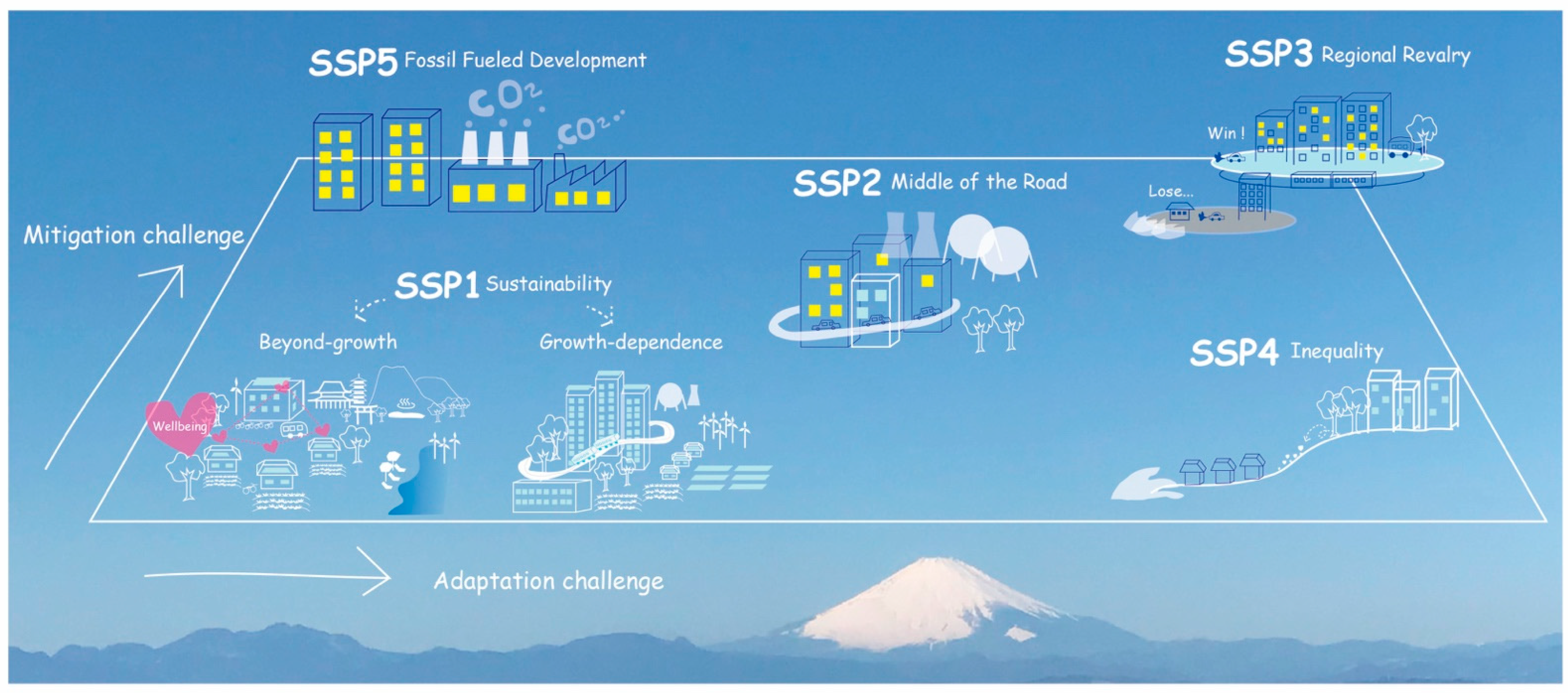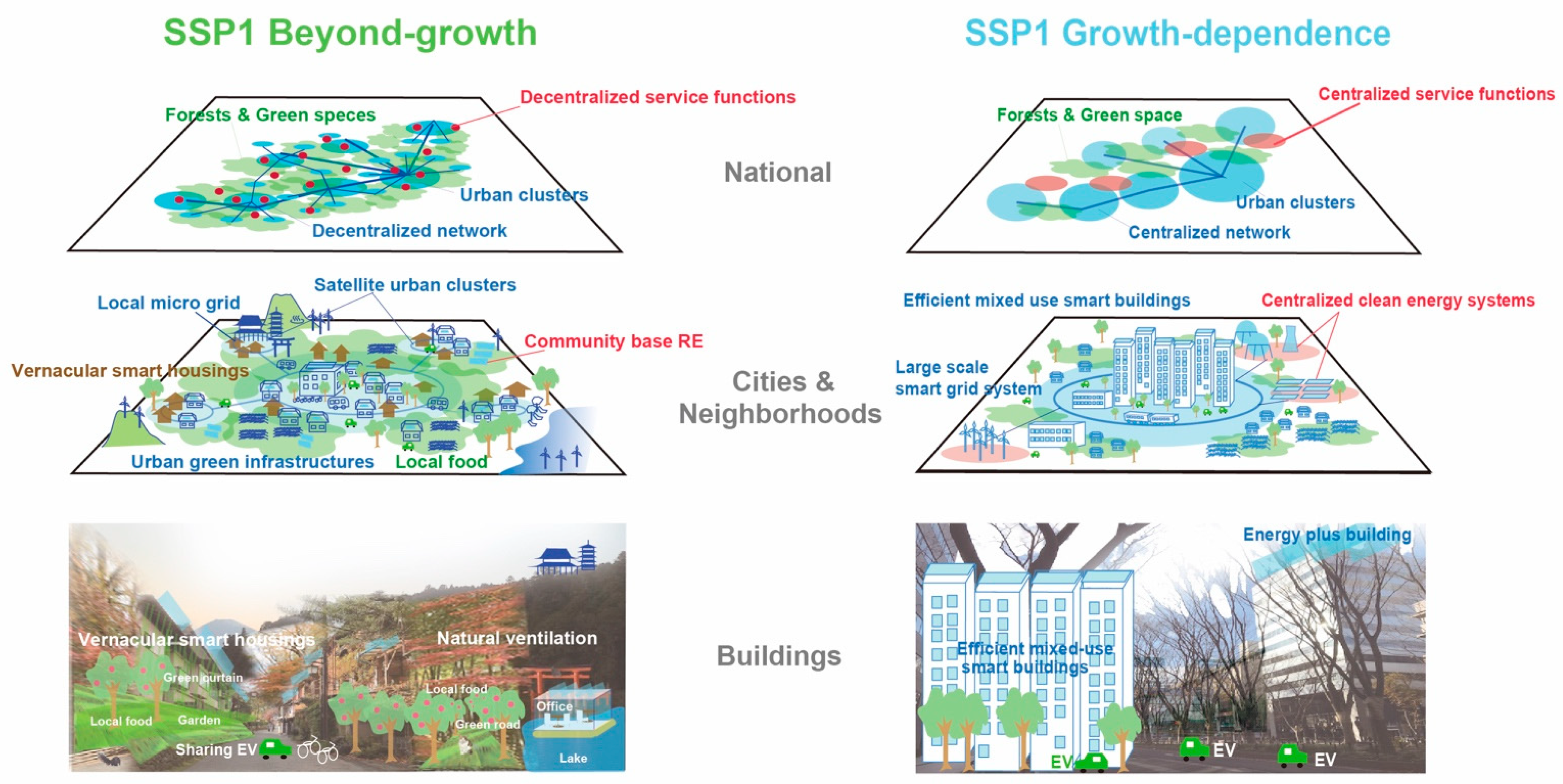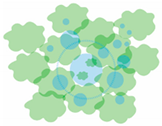A Future Outlook of Narratives for the Built Environment in Japan
Abstract
:1. Introduction
2. Methodology
3. Theoretical Background
3.1. Japanese Experiences of Urban and Societal Transformations
3.2. Transformation of Fundamental Lifestyle and Well-Being in the Japanese Context
3.3. Nature-Based Solution toward Sustainability beyond Growth
4. Narratives of Pathways for Japan
4.1. SSP1 Growth-dependence
4.2. SSP1 Beyond-growth
4.3. SSP2
4.4. SSP3
4.5. SSP4
4.6. SSP5
5. Benefits and Trade-Offs in System Alternatives between SSP1 Beyond-growth and SSP1 Growth-dependence
6. Global Crises, Impacts, and Recovery
7. Conclusions
Author Contributions
Funding
Acknowledgments
Conflicts of Interest
References
- Foresight Sustainable Energy Management and the Built Environment Project; Final Project Report; The Government Office for Science: London, UK, 2008.
- Francart, N.; Malmqvist, T.; Hagbert, P. Climate target fulfilment in scenarios for a sustainable Swedish built environment beyond growth. Futures 2018, 98, 1–18. [Google Scholar] [CrossRef] [Green Version]
- Makido, Y.; Dhakal, S.; Yamagata, Y. Relationship between urban form and CO2 emissions: Evidence from fifty Japanese cities. Urban Clim. 2012. [Google Scholar] [CrossRef] [Green Version]
- International Energy Agency (IEA). Statistics Report: CO2 Emissions from Fuel Combustion; IEA: Paris, France, 2020. [Google Scholar]
- Agency for Natural Resource and Energy Japan, Energy White Paper Japan; METI: Tokyo, Japan, 2020.
- Barthelemy, M.; Bordin, P.; Berestycki, H.; Gribaudi, M. Self-organization versus top-down planning in the evolution of a city. Sci. Rep. 2013, 3. [Google Scholar] [CrossRef] [Green Version]
- Houet, T.; Marchadier, C.; Bretagne, G.; Moine, M.P.; Aguejdad, R.; Viguié, V.; Bonhomme, M.; Lemonsu, A.; Avner, P.; Hidalgo, J.; et al. Combining narratives and modelling approaches to simulate fine scale and long-term urban growth scenarios for climate adaptation. Environ. Model. Softw. 2016, 86, 1–13. [Google Scholar] [CrossRef]
- Levesque, A.; Pietzcker, R.C.; Baumstark, L.; De Stercke, S.; Grübler, A.; Luderer, G. How much energy will buildings consume in 2100? A global perspective within a scenario framework. Energy 2018. [Google Scholar] [CrossRef] [Green Version]
- Tozer, L.; Klenk, N. Discourses of carbon neutrality and imaginaries of urban futures. Energy Res. Soc. Sci. 2018, 35, 174–181. [Google Scholar] [CrossRef]
- Kamei, M.; Kurisu, K.; Hanaki, K. Evaluation of long-term urban transitions in a megacity’s building sector based on alternative socioeconomic pathways. Sustain. Cities Soc. 2019, 47, 101366. [Google Scholar] [CrossRef]
- van Vuuren, D.P.; Carter, T.R. Climate and socio-economic scenarios for climate change research and assessment: Reconciling the new with the old. Clim. Chang. 2014, 122, 415–429. [Google Scholar] [CrossRef] [Green Version]
- Amer, M.; Daim, T.U.; Jetter, A. A review of scenario planning. Futures 2013. [Google Scholar] [CrossRef]
- Hiltunen, E. Scenarios: Process and outcome. J. Futur. Stud. 2009, 13, 151–152. [Google Scholar]
- O’Neill, B.C.; Kriegler, E.; Ebi, K.L.; Kemp-Benedict, E.; Riahi, K.; Rothman, D.S.; van Ruijven, B.J.; van Vuuren, D.P.; Birkmann, J.; Kok, K.; et al. The roads ahead: Narratives for shared socioeconomic pathways describing world futures in the 21st century. Glob. Environ. Chang. 2017. [Google Scholar] [CrossRef] [Green Version]
- O’Neill, B.C.; Kriegler, E.; Riahi, K.; Ebi, K.L.; Hallegatte, S.; Carter, T.R.; Mathur, R.; van Vuuren, D.P. A new scenario framework for climate change research: The concept of shared socioeconomic pathways. Clim. Chang. 2014. [Google Scholar] [CrossRef] [Green Version]
- Riahi, K.; van Vuuren, D.P.; Kriegler, E.; Edmonds, J.; O’Neill, B.C.; Fujimori, S.; Bauer, N.; Calvin, K.; Dellink, R.; Fricko, O.; et al. The Shared Socioeconomic Pathways and their energy, land use, and greenhouse gas emissions implications: An overview. Glob. Environ. Chang. 2017. [Google Scholar] [CrossRef] [Green Version]
- Chen, H.; Matsuhashi, K.; Takahashi, K.; Fujimori, S.; Honjo, K.; Gomi, K. Adapting global shared socio-economic pathways for national scenarios in Japan. Sustain. Sci. 2020. [Google Scholar] [CrossRef] [Green Version]
- Kamei, M.; Hanaki, K.; Kurisu, K. Tokyo’s long-term socioeconomic pathways: Towards a sustainable future. Sustain. Cities Soc. 2016, 27. [Google Scholar] [CrossRef]
- Maury, O.; Campling, L.; Arrizabalaga, H.; Aumont, O.; Bopp, L.; Merino, G.; Squires, D.; Cheung, W.; Goujon, M.; Guivarch, C.; et al. From shared socio-economic pathways (SSPs) to oceanic system pathways (OSPs): Building policy-relevant scenarios for global oceanic ecosystems and fisheries. Glob. Environ. Chang. 2017. [Google Scholar] [CrossRef]
- Kamei, M.; Wangmo, T.; Leibowicz, B.D.; Nishioka, S. Urbanization, carbon neutrality, and Gross National Happiness: Sustainable development pathways for Bhutan. Cities 2020. [Google Scholar] [CrossRef]
- Frame, B.; Lawrence, J.; Ausseil, A.G.; Reisinger, A.; Daigneault, A. Adapting global shared socio-economic pathways for national and local scenarios. Clim. Risk Manag. 2018, 21, 39–51. [Google Scholar] [CrossRef]
- O’Neill, B.C.; Carter, T.R.; Ebi, K.; Harrison, P.A.; Kemp-Benedict, E.; Kok, K.; Kriegler, E.; Preston, B.L.; Riahi, K.; Sillmann, J.; et al. Achievements and needs for the climate change scenario framework. Nat. Clim. Chang. 2020. [Google Scholar] [CrossRef]
- van Ruijven, B.J.; Levy, M.A.; Agrawal, A.; Biermann, F.; Birkmann, J.; Carter, T.R.; Ebi, K.L.; Garschagen, M.; Jones, B.; Jones, R.; et al. Enhancing the relevance of shared socioeconomic pathways for climate change impacts, adaptation and vulnerability research. Clim. Chang. 2014. [Google Scholar] [CrossRef] [Green Version]
- Absar, S.M.; Preston, B.L. Extending the Shared Socioeconomic Pathways for sub-national impacts, adaptation, and vulnerability studies. Glob. Environ. Chang. 2015. [Google Scholar] [CrossRef] [Green Version]
- Chen, H.; Chen, W. Carbon mitigation of China’s building sector on city-level: Pathway and policy implications by a low-carbon province case study. J. Clean. Prod. 2019. [Google Scholar] [CrossRef]
- van Vuuren, D.P.; Edmonds, J.; Kainuma, M.; Riahi, K.; Thomson, A.; Hibbard, K.; Hurtt, G.C.; Kram, T.; Krey, V.; Lamarque, J.F.; et al. The representative concentration pathways: An overview. Clim. Chang. 2011. [Google Scholar] [CrossRef]
- Pereira, L.M.; Davies, K.K.; Belder, E.; Ferrier, S.; Karlsson-Vinkhuyzen, S.; Kim, H.; Kuiper, J.J.; Okayasu, S.; Palomo, M.G.; Pereira, H.M.; et al. Developing multiscale and integrative nature–people scenarios using the Nature Futures Framework. People Nat. 2020. [Google Scholar] [CrossRef]
- Lundquist, C.J.; Pereira, H.M.; Alkemade, R.; den Belder, E.; Carvalho Ribeiro, S.; Davies, K.; Greenaway, A.; Hauck, J.; Karlsson-Vinkhuyzen, S.; Kim, H.; et al. Visions for Nature and Nature’s Contributions to People for the 21st Century. 2017. Available online: http://www.niwa.co.nz/naturefutures (accessed on 28 January 2021).
- Gottmann, J. Megalopolis or the Urbanization of the Northeastern Seaboard. Econ. Geogr. 1957. [Google Scholar] [CrossRef]
- Hellman, L. Learning from Las Vegas. Built Environ. 1982. [Google Scholar] [CrossRef]
- TWI2050. Innovations for Sustainability: Pathways to an Efficient and Post-Pandemic Future; IIASA: Laxenburg, Austria, 2020; ISBN 978-3-7045-0157-8. [Google Scholar]
- Jackson, T. Prosperity without growth. In Globalisation, Economic Transition and the Environment: Forging a Path to Sustainable Development; Earthcan: New York, NY, USA, 2013; ISBN 9781781951415. [Google Scholar]
- Cooper, R.N.; Layard, R. Happiness: Lessons from a New Science. Foreign Aff. 2005, 84. [Google Scholar] [CrossRef]
- Easterlin, R.A. Income and happiness: Towards a unified theory. Econ. J. 2001, 111, 465–484. [Google Scholar] [CrossRef]
- Bettencourt, L.M.A.; Lobo, J.; Helbing, D.; Kühnert, C.; West, G.B. Growth, innovation, scaling, and the pace of life in cities. Proc. Natl. Acad. Sci. USA 2007, 104, 7301–7306. [Google Scholar] [CrossRef] [PubMed] [Green Version]
- Rydin, Y. The Future of Planning: Beyond Growth Dependence; Policy Press: Bristol, UK, 2013; ISBN 9781447308423. [Google Scholar]
- Sugden, R.; Sen, A. Commodities and Capabilities. Econ. J. 1986, 96, 820–822. [Google Scholar] [CrossRef]
- Batty, M. Inventing Future Cities; MIT Press: Cambridge, MA, USA, 2018. [Google Scholar]
- IPCC. Climate Change and Land. An IPCC Special Report on Climate Change, Desertification, Land Degradation, Sustainable Land Management, Food Security, and Greenhouse Gas Fluxes in Terrestrial Ecosystems. 2019. Available online: https://www.ipcc.ch/srccl/ (accessed on 28 January 2021).
- Devolder, S.; Block, T. Transition thinking incorporated: Towards a new discussion framework on sustainable urban projects. Sustainability 2015, 7, 3269–3289. [Google Scholar] [CrossRef] [Green Version]
- Keeler, B.L.; Hamel, P.; McPhearson, T.; Hamann, M.H.; Donahue, M.L.; Meza Prado, K.A.; Arkema, K.K.; Bratman, G.N.; Brauman, K.A.; Finlay, J.C.; et al. Social-ecological and technological factors moderate the value of urban nature. Nat. Sustain. 2019, 2, 29–38. [Google Scholar] [CrossRef]
- FAO. 2017 The State of Food and Agrivulture Leveraging Food Systems for Inclusive Rural Transformation; FAO: Rome, Italy, 2017; ISBN 9789251098738. [Google Scholar]
- Lafortezza, R.; Sanesi, G. Nature-based solutions: Settling the issue of sustainable urbanization. Environ. Res. 2019, 172, 394–398. [Google Scholar] [CrossRef] [PubMed]
- Alexander, C.; Ishikawa, S.; Silverstein, M. A Pattern Language: Towns, Buildings, Construction (Cess Center for Environmental); Oxford University Press: Oxford, UK, 1977; ISBN 0195019199. [Google Scholar]
- IPBES Global Assessment Report on Biodiversity and Ecosystem Service. Debating Nature’s Value; IPBES Secretariat: Bonn, Germany, 2019. [Google Scholar]
- Saito, O.; Kamiyama, C.; Hashimoto, S.; Matsui, T.; Shoyama, K.; Kabaya, K.; Uetake, T.; Taki, H.; Ishikawa, Y.; Matsushita, K.; et al. Co-design of national-scale future scenarios in Japan to predict and assess natural capital and ecosystem services. Sustain. Sci. 2019, 14, 5–21. [Google Scholar] [CrossRef]
- IIASA. TWI2050 Report: Transformations to Achieve the Sustainable Development Goals; Report Prepared by The World in 2050 Initiative; IIASA: Laxenburg, Austria, 2018. [Google Scholar]
- IPBES. Global Assessment Report on Biodiversity and Ecosystem Services of the Intergovernmental Science-Policy Platform on Biodiversity and Ecosystem Services; IPBES Secretariat: Bonn, Germany, 2019. [Google Scholar]
- Sachs, J.D.; Schmidt-Traub, G.; Mazzucato, M.; Messner, D.; Nakicenovic, N.; Rockström, J. Six Transformations to achieve the Sustainable Development Goals. Nat. Sustain. 2019, 2, 805–814. [Google Scholar] [CrossRef]
- Rockström, J.; Klum, M. Big World, Small Planet: Abundance within Planetary Boundaries; Bokförlaget Max Ström: Stockholm, Sweden, 2015; ISBN 9780300218367. [Google Scholar]
- Vilhena, D.A.; Antonelli, A. A network approach for identifying and delimiting biogeographical regions. Nat. Commun. 2015. [Google Scholar] [CrossRef]
- Nakicenovic, N.; Messner, D.; Zimm, C.; Clarke, G.; Rockström, J.; Aguiar, A.P.; Boza-Kiss, B.; Campagnolo, L.; Chabay, I.; Collste, D.; et al. The Digital Revoluion and Sustainable Development: Opportunities and Challenges Report; IIASA: Laxenburg, Austria, 2019; ISBN 9783704501554. [Google Scholar]
- Rudofsky, B. Architecture without Architects: A Short Introduction to Non-Pedigreed Architecture. Art Educ. 1970, 23, 71. [Google Scholar] [CrossRef]
- Lynch, K. The Image of the City; MIT Press: Cambridge, MA, USA, 1960; ISBN 9781315816852. [Google Scholar]
- Mostafavi, M. Why Ecological Urbanism? Why Now? Harvard University Press: Cambridge, MA, USA, 2010. [Google Scholar]
- Hester, R. Design for Ecological Democracy; MIT Press: Cambridge, MA, USA, 2010. [Google Scholar]


| Shared socio-economic pathways (SSPs) Element | SSP1 Beyond-growth | SSP1 Growth-dependence | SSP2 | SSP3 | SSP4 | SSP5 |
|---|---|---|---|---|---|---|
| Basic elements | ||||||
| Population [17] | Moderate decrease | Moderate decrease | Moderate decrease | Strong decrease | Strong decrease | Marginal decrease |
| Population density pattern (Distribution of DID * area, SSP2 represents current.) |  |  |  |  |  |  |
| Rural–Urban migration | Relatively small | Increase | Increase | Stay same | Increase | Increase |
| Urban–Rural migration | Increase | Relatively small | Relatively small | Stay same | Relatively small | Decrease |
| Urbanization | Slight increase | Slight increase | Constant | Decrease | Slight decrease | Strong increase |
| GDP growth [17] | Moderate (Lower than SSP1 Growth-dependence) | Moderate | Moderate | Low | Moderate | High |
| Inequality | Decrease | Relatively decrease | Increase between large and small cities | Increase | Increase between large and small cities | Strong increase |
| Cities/Neighborhoods | ||||||
| Urban form (Representative characteristics) | Center core and satellite clusters. | Balance between metropolis and middle-small cities. | Unbalanced monocentric with shrinkage. | Monocentric. Small cities at risk of disappearing. | Division between central and surrounding areas. | Monocentric. |
| Representative urban form diagram |  |  |  |  |  |  |
| Access to quality of nature | Green neighborhoods with access for all the residents. Good functions for food production, green spaces, and daily activities. | Urban centers with limited access. Suburbs with more access and well conserved. | Urban areas with access limited to parks and rural areas (agriculture + forest) | Suburbs with limited green space. Not well maintained. | Rural areas with good access. Not well maintained with some disaster risks. | Urban areas with little access. Little attention paid to green spaces. |
| Access to basic services | High. Balanced and flexible small scales service networks are more adopted. | High. Center has better access overall. | Medium. Large cities have better and higher quality services. | Low. Service networks are old and inefficient. | Low (unequal). Large cities have high quality services. Small cities and suburbs have insufficient services. | High. Urban centers have better quality and secured access. |
| Infrastructure | Service infrastructure is decentralized and community based. | Centralized and heavy service infrastructures are located outside of cities. | Only center is well maintained. Maintenance is fragmented in suburbs. | Only large cities have sufficient maintenance. | Maintenance and upgrades rely on the densities and their local economies. | Further extensions occur in large cities for new residents and industries. |
| Buildings | ||||||
| Building types | Mid-rise and low-rise. Wooden buildings increase. Local materials increase. | CC: high-rise. S: mid-rise to low-rise. Non-wooden buildings increase. | CC: high-rise. S: mid- to low-rise. Non-wooden buildings increase in large cities. | CC: high-rise. S: low-rise. Vacant buildings increase in suburbs and local cities. | CC: high-rise. S: low-rise. L: mid-rise and low-rise (wooden housing). | CC: high-rise. S: mid- to low-rise. Vacant buildings significantly increase in local cities. |
| Energy efficiency and technology | High. Hybrid systems (automation and natural ventilation) are adopted and improve energy efficiency and material use. | High. Overall smart automation systems are adopted and significantly increase energy efficiency. | Moderate. New updated buildings install efficient technologies. | Low. Old stocks increase and efficient technologies cannot be installed overall. | Inequal. Energy efficiency improvements and new technologies adoption heavily depend on income groups. | Moderate. Only large cities significantly improve energy efficiency and upgrade the technologies. |
| Building life time | Overall life time is extended with increase of renovations and reuse of vacant space, while local housings (wooden) have relatively short cycle. | Increase. | Constant with some renovations. | Short. | CC: Constant with some renovations. S: Short. | Decrease with high economic growth. |
| Lifestyles | ||||||
| Space per capita | Relatively smaller than today. | Relatively larger than today. | Stay same. | Relatively small space in urban and large in rural. | Increase in higher income areas, decrease in lower income areas. | Overall relatively small due to the limitation of land space. |
| Production & Consumption patterns | Decentralized production system with local circular economy. | Centralized production system with efficient domestic and global logistics systems. | Existing production clusters and large cities that are center of consumption. | Mismatched production and consumption within the domestic markets. | Significant inequality in consumption among domestic regions. | Increased overall production and consumption with less improvement of efficiency. |
| Commuting | Sharing mobility as well as small scale public transport increase. Walking and cycling are promoted. | Speed and efficiency are key. Vertical access also increases with high-rise buildings. | High speed connections are accelerated within the country. However, local transport systems are not sufficient. | Only large cities maintain efficient public transport services. Small cities and suburbs suffer from daily commutes. | Public transport services are maintained only in city centers. Residents of suburbs and rural areas use individual cars. | High speed trains and all logistics are promoted to accelerate the economies. People use more cars and trains for their holidays. |
| Energy demand | Maximum use of natural passive systems for heating, cooling, and lighting decreases energy demand per capita. Increase in walking and cycling also decrease energy demand for commutes. | Overall, use of efficient technologies decreases energy use per capita. However, technology devices per capita increase, which contribute to increased demand. | Improved energy efficiency gradually decreases energy demand per capita. However, old stocks still largely exist and increase energy demand. | Only successful cities update the building standard. However, overall energy demand per capita is high. | Only large-scale, compact cities improve their energy efficiency and decrease overall demand. Small cities suffer from old infrastructures with high energy demand. | Areas with strong economies update to new, highly efficient technologies. However, demand per capita still increases with increases in activities, and consumption. |
Publisher’s Note: MDPI stays neutral with regard to jurisdictional claims in published maps and institutional affiliations. |
© 2021 by the authors. Licensee MDPI, Basel, Switzerland. This article is an open access article distributed under the terms and conditions of the Creative Commons Attribution (CC BY) license (http://creativecommons.org/licenses/by/4.0/).
Share and Cite
Kamei, M.; Mastrucci, A.; van Ruijven, B.J. A Future Outlook of Narratives for the Built Environment in Japan. Sustainability 2021, 13, 1653. https://doi.org/10.3390/su13041653
Kamei M, Mastrucci A, van Ruijven BJ. A Future Outlook of Narratives for the Built Environment in Japan. Sustainability. 2021; 13(4):1653. https://doi.org/10.3390/su13041653
Chicago/Turabian StyleKamei, Miho, Alessio Mastrucci, and Bas J. van Ruijven. 2021. "A Future Outlook of Narratives for the Built Environment in Japan" Sustainability 13, no. 4: 1653. https://doi.org/10.3390/su13041653
APA StyleKamei, M., Mastrucci, A., & van Ruijven, B. J. (2021). A Future Outlook of Narratives for the Built Environment in Japan. Sustainability, 13(4), 1653. https://doi.org/10.3390/su13041653







